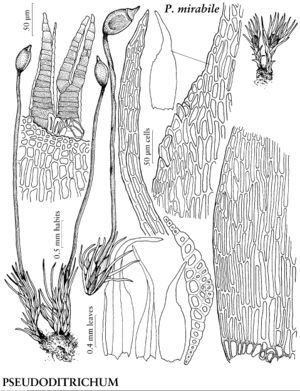Difference between revisions of "Pseudoditrichum mirabile"
Canad. J. Bot. 52: 701, figs. 1 – 46. 1974.
FNA>Volume Importer |
imported>Volume Importer |
||
| (One intermediate revision by the same user not shown) | |||
| Line 54: | Line 54: | ||
|publication year=1974 | |publication year=1974 | ||
|special status=Endemic;Illustrated | |special status=Endemic;Illustrated | ||
| − | |source xml=https:// | + | |source xml=https://bitbucket.org/aafc-mbb/fna-data-curation/src/2e0870ddd59836b60bcf96646a41e87ea5a5943a/coarse_grained_fna_xml/V28/V28_303.xml |
|genus=Pseudoditrichum | |genus=Pseudoditrichum | ||
|species=Pseudoditrichum mirabile | |species=Pseudoditrichum mirabile | ||
Latest revision as of 21:35, 5 November 2020
Plants very small. Stems 0.1–0.3 cm. Leaves secund; margins serrulate to irregularly serrate at shoulders. Specialized asexual reproduction common, by ± spheric, reddish brown rhizoidal tubers, and filiform to bulbiform axillary gemmae. Seta 0.6 cm. Calyptra fugacious, smooth or slightly papillose distally. Spores shed singly, 15–21 µm, papillose.
Phenology: Capsules mature summer (Jul).
Habitat: Moist calcareous silt, under Populus
Elevation: moderate elevations (200 m)
Discussion
Of conservation concern.
Pseudoditrichum mirabile was collected in 1948 but not described until 1974. The gametophytes look like those of a very small Ditrichum, but the peristome is definitely diplolepidous (therefore this taxon is not related to Ditrichum). Pseudoditrichum mirabile has not been recollected since its discovery. Great Bear Lake is an unlikely place to find the only population of an endemic species, genus, and family, but the plants have a unique combination of gametophyte and sporophyte features that do not fit into any other family.
Selected References
None.

